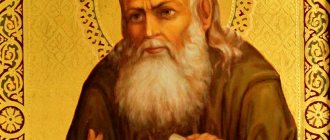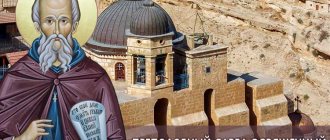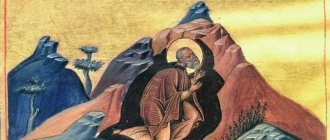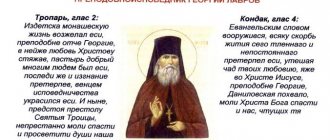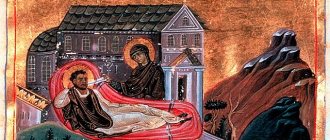Among the first Christians who gave their lives for the Good News was the holy martyr Julia (Julia, that’s how her name is now pronounced). Her icon is now revered throughout the Christian world.
The icon of the saint is revered by both Christians and Catholics. In the small church in Nontse, on the spot where the saint tragically died, there is her icon and part of her relics. The church was consecrated in honor of St. Julia.
Life
There are two legends, repeating each other only in separate fragments. According to one of them, Saint Julia (or Julia) was born in Carthage, into a noble family. She grew up as an obedient, beautiful, intelligent and sympathetic girl. She prayed earnestly and read the Holy Scriptures. When the city was captured by the Vandals in 439, a ten-year-old girl was captured and soon sold into slavery to the Syrian merchant Eusebius. Despite her situation, Julia found freedom within herself and began to work conscientiously. Her owner was a pagan and more than once argued with the girl, asking her to convert to paganism. Julia was devoted to Christ. She continued to pray fervently and, with the permission of Eusebius himself, occasionally read the Holy Scriptures.
Several years passed like this. One day the owner loaded the ship with various goods, took the girl with him (as a talisman to protect against troubles) and set off for Gaul, a rich country at that time. Eusebius ordered a landing in Corsica (near the city of Nonza), where a bull was sacrificed to the pagan gods. He decided to join the celebration. The young Christian woman asked to stay on the ship. She cried that so many people live in error.
When the local governor, Felix Saxo, found out about the Christian slave, he got Eusebius drunk. After the guest fell asleep, by order of Felix, Julia was lowered ashore. The governor ordered the young maiden to make a sacrifice to the gods. The bold refusal infuriated Felix. And Julia was immediately sentenced to death through cruel torture. The girl’s face was bloodied, she was dragged by her hair, and then crucified. During the torture, Julia whispered prayers. She did not resist, but humbly accepted her fate. With her last breath, a dove flew out of the martyr’s mouth as a symbol of purity and innocence. Neither bird nor animal touched the girl's body after her death.
This is precisely the version of the life of Saint Julia that the clergy in the diocese of Ajaccio adhere to.
Fate
Little Yulechka often grows up to be everyone’s favorite and has a friendly, fair character. He likes to play outdoor games with friends, but he knows when to stop, he will never agree to a dangerous game, he will not climb a tree or get into a fight. Parents will not have to worry about their daughter; she will not get involved with bad company even in adolescence. As a child, she learns to read and write early, loves to learn new things, but laziness prevents her from achieving great success. Although Yulia is always surrounded by friends, she is not a leader among them, since she does not like to stand out from the crowd and knows how to adapt to people.
Yulia’s transitional age, to the delight of her family, passes calmly, without strong emotional outbursts. He studies at school averagely, without much success. Good grades can only be achieved in favorite subjects and has the ability to learn foreign languages. Rarely participates in school events due to shyness and reluctance to stand out. She has practically no close friends, because she tries not to let anyone into her soul. Yulechka is always in a good mood, rarely gets irritated and never without reason.
Adult Yulechka turns into a charming and attractive woman. He always dresses with taste, choosing his clothes carefully, loves jewelry, and always has his hair and nails done. He knows how to support any topic with his interlocutor, and can gossip without malice. He does not tolerate rudeness, rudeness, lies, and immediately cuts such people off from his society. Surrounds himself, first of all, with useful people from whom he can benefit. At times she can be overly trusting and can become a victim of scammers.
Another version
According to the second version, which is also welcomed by the Corsicans, Julia was a native of the city of Nonza and a contemporary of Saint Devota (about 303). For refusing to bow to pagan idols and sacrifice to them, the girl was tortured and then killed. They cut off both her breasts and threw them off a cliff. In the place where they fell, two healing springs opened. After this, the enraged executioners tied Saint Julia to a fig tree, where she died in pain. At this time, a dove flew out of the maiden’s mouth. This moment exactly repeats the previous version of the life of the martyr.
Angel Julia Day
So, every person’s Angel Day can happen on any day. Everything will depend on when, in childhood, the child was brought to church to be baptized by his parents.
Believers try to adhere to the ancient tradition of baptizing a child on the 40th day after birth. But some people receive Holy Baptism as adults. So, people with the same names can have their name day on the same day, but Angel Day almost never.
Icon
Icons depicting saints carry spiritual value. They protect, preserve and help believers in difficult situations. Many women with the name Julia and others turn to the image of the martyr. It is a symbol of unshakable faith and chastity. There are several options for embodying the image of the Virgin Julia.
The Corsican version of the life is directly reflected in the iconography. The Holy Martyr Julia is depicted crucified on the cross, with her nipples cut off. An example of this is a painting dating back to the 16th century. It has survived to this day and is located in the Church of the Holy Martyr in the city of Nontse. There you can also venerate the statue of a Christian virgin. According to local confessors, the image is miraculous. Everyone who turns to him with sincere prayer receives blessing and help.
On Orthodox icons, Saint Julia is traditionally represented with the Holy Scriptures (or a crucifix in her hand). There are also so-called family images, in which the martyr is depicted together with other saints (St. Vladislav, Prince of Serbia, St. Nadezhda of Rome, the young woman, St. David of Thessalonica). Also, folk craftsmen have proposed several options for the execution of icons. The faces of St. Julia embroidered with beads are considered real masterpieces. Characteristic points here are white clothes as a symbol of the virgin’s purity and innocence and a look full of courage.
Body icons or medallions are becoming more and more popular. They are made by jewelers from silver and gold and are spiritual amulets for believers. Usually these are images of the face of St. Julia. Rare ones include jewelry images of the martyr in the hands of the Guardian Angel.
Julia's name day according to the church calendar - love, family, character
The weightless name Julia arose from the Roman male name Julius.
In the female version it means “fluffy”, “airy”. Belongs to the category of ancient names that are still popular all over the world. Pronunciation of the name Julia in different countries of the world: England - Julius, Germany - Julchen, France - Julie, Spain - Julia, Portugal - Julia, Italy - Julie, Corsica - Dyulia, Czech Republic - Julia, Denmark - Julia, Ireland - Yule, Japan - Hadzeka.
Diminutive form of the name: Yulchonok, Julianna, Yulechka, Julia, Yulka, Yulchik, Yul, Yulenka, Julie, Julia, Juliet.
Reverence
The Corsican martyr of Nonza has been revered since her brutal murder. For this purpose, a sanctuary (or sanctuary) was built near the city. However, in 734 it was destroyed by barbarians. In addition, holy springs are open on the island, to which local pilgrims flock with requests for healing and protection.
Saint Julia's Day is celebrated annually in Corsica. The martyr herself, according to the decree of the Sacred Congregation of Rites of August 5, 1809, is considered the patroness of the island.
In the Orthodox Church, the feast day of St. Julia is considered July 29 (new style).
Martyr Julia of Ankyra (Corinthian), memorial date: May 31, New Age.
Her life is associated with the martyr Theodotus and seven virgins - martyrs Tekusa, Faina, Claudia, Matrona, Alexandra and Euphrasinia. They all lived in the third century in the city of Ancyra.
Saint Theodotus was married at that time and had his own hotel. Despite this, he lived in purity and wherever possible he led people to Christianity with his conversations. From the Lord he received the gift of healing.
Many people fled the city, abandoned their homes and farms. Famine reigned in Ancyra. Saint Theodotus sheltered many Christians in his hotel. The Divine Liturgy was also celebrated secretly here.
Relics
According to one legend, the body of the martyr was discovered by the monks of the island of Gorgon and buried in their monastery. Before this, an angel appeared to them and told about the girl’s suffering and her feat for the sake of the faith of Christ.
Much later, the holy relics were transferred to the city of Brescia in northern Italy. Every year thousands of believers come here to venerate Saint Julia of Carthage and ask for help. Here you can also purchase icons of the martyr. According to the clergy, she is the patron of mothers and sick children.
Family
Despite numerous love affairs and an army of fans, Julia is in no hurry to get married, as she has high demands on her future husband. She may refuse to marry her loved one, with whom she is head over heels in love and with whom she has been dating for a long time. But because there is some kind of negative in his character that is unacceptable for her list of positive qualities of her future husband. Julia nevertheless finds this ideal man for the role of husband, after which she becomes for him the best wife in the world, economical and caring, able to create home comfort. For the sake of her family, Julia will quit her job without hesitation and become a housewife. Yulechka, who sometimes loves to gossip with her friends, will not wash dirty linen in the family, trying to make everyone think that she has an exemplary family, even if this is not the case. Julia will be a very caring and loving mother to her children, even too much. Julia will do anything for her children, even get a star from the sky.
Source
Prayer
Absolutely everyone who needs help and healing can turn to the image of Saint Julia in prayer. In Orthodox sources you can find a troparion in honor of the martyr. It is often attached to personalized icons. Also, invoking a saint is possible with the help of a common prayer: “Pray to God for me, holy saint of God, Martyr Julia, as I diligently resort to you, an ambulance and prayer book for my soul.” It is after this part of the address to the saint, according to Orthodox custom, that the troparion is to be read.
Julia's name day according to the church calendar
Every year Orthodox people celebrate name days. According to the church calendar, the Day of Remembrance of the Holy Patroness Julia is celebrated several times a year.
In common people, name days are also called Angel Day, although there are differences between these days.
Name days are celebrated on the day of remembrance of the Patron Saint, and Angel Day is the day of receiving the Sacrament of Baptism. Orthodox believers attach special significance to these days - just like on their own birthday, they try to confess and take communion, so that the holiday is not only physical, but also spiritual, from unity with the Lord.
Interesting Facts
The city of Sainte-Julie in Canada, Quebec, is named after Saint Julia of Carthage. An asteroid that was discovered in 1866 is also named after her.
In the Orthodox tradition, another martyr named Julia is venerated. She is one of the seven holy virgins who were drowned in the lake after cruel torture for the faith of Christ. Later their bodies were burned by the pagans. The saint is called Ancyra (or Corinth) after her place of birth. Her memory day is celebrated on May 31 and November 19 according to the new style.
In the 7th-8th centuries. The church at the burial site of the martyr fell into disrepair and was partially destroyed. The inhabitants of Corsica decided to build a new temple in honor of Saint Julia. They collected stones, sand, bricks and left them in the place they chose to erect the building. But on the night before the foundation was laid, someone’s invisible hand carried all the materials to the foot of the old church. Perplexed, people returned everything to a new place. But the next night the same thing happened. According to legend, watchmen watched as the bright maiden transported materials on white oxen. People realized that Saint Julia did not want the temple to be built in a new place. Therefore, the place of her burial was cleared and a new church was erected in honor of the martyr.
Career
Not very hardworking, Yulia rarely reaches career heights; work does not come first for her. Throughout her life, Julia can change several jobs, especially if the work is monotonous. Creative professions are more suitable for her, for example, actress, artist, musician, journalist, hairdresser, designer, photographer. Despite her tendency towards laziness, Julia does her work conscientiously and loves to be praised. She has the ability to communicate and smooth out conflicts; she will make an excellent teacher and educator. Thanks to her excellent intuition, she can become an excellent lawyer or psychologist.
